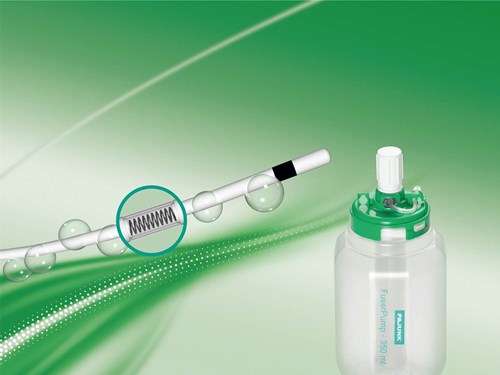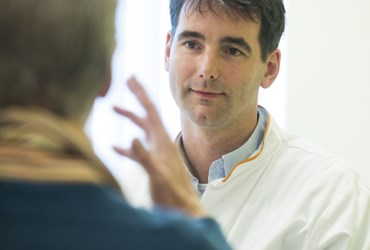Patients who are recovering from intestinal surgery after colon cancer often receive morphine to manage their pain. The side effects associated with this painkiller, such as nausea and confusion, can be dangerous for the patients, who are usually over 70 years old. Plus, opioid addiction is becoming an increasingly pressing issue. That is why VieCuri Medical Centre in Venlo adopted a smart alternative a few years ago: the continuous pain management catheter. This treatment method involves placing a thin tube inside the wound right after the operation. The tube runs across the peritoneum and is connected to a vacuum pump. The pump continuously transports non-morphine pain medication to the place where the nerves that are responsible for most of the pain are located. The pump distributes the pain medication for 72 hours. Afterwards, the pump and tube are easy to remove. The result of the continuous pain management catheter is that patients feel little pain, are no longer nauseous, do not suffer from constipation and regain their mobility quickly so they can work on their recovery at home. In part due to the relentless commitment of Jeroen Vogelaar, surgeon-oncologist at VieCuri, the pain management catheter was broadly deployed across VieCuri in no time and the innovation won the silver ‘Zinnige Zorg Award’ [Sensible Care] and audience prize by VGZ.

Trigger & implementation
Medical technology company Pajunk had been researching the deployment of their pain management catheter for some time. Based on existing literature and their own research, they found out that existing catheters are often placed in the wrong place in the body. Pajunk concluded that the catheter should be placed on the peritoneum, where the visceral branches causing a lot of post-surgery pain in intestinal cancer patients and others are located. “I had already approached several hospitals with our idea but some physicians did not believe in it. It’s a matter of finding the right person, someone who is open to experimentation and innovation”, says Elly Roos, regional manager at Pajunk. That person was surgeon-oncologist Vogelaar, whose enthusiasm for such innovations was widely known at the hospital.
Shortly after the initial contact between Vogelaar and Roos, a pilot was set up late 2018, funded by Pajunk, with 10 colon cancer patients who received the continuous pain management catheter to recover after their operation. The project was conducted according to an internal protocol involving a special VieCuri committee, which included a material expert, a technician, a pharmacist, an anaesthesiologist and a specialist, Dr. Vogelaar himself. Together, they developed a risk inventory model that provided a score to indicate the reliability and safety of the catheter. Once the treatment was found to be safe, the pilot was ready for kick-off. But a lot of scepticism remained among internal colleagues about this new way of post-surgery recovery. Vogelaar: “There will always be people who are reluctant to innovate in healthcare. For this reason, I always went to see if everything had gone well the first two times after a colleague’s operation, to show that I was involved and to see if anything could be improved in the process. I also made presentations to our nurses and posted videos to their WhatsApp group to explain the pain management catheter. At a certain point, people gain confidence in the technology and practice shows them that it is safe. It is also simply a matter of getting used to a new technique. It used to take us 5-10 minutes to place the catheter at first, now we’re done in 3 minutes.” Having an enthusiastic initiator who is also active on the floor proved to be of great importance, Roos concurs: “What generated a lot of confidence was the continuous involvement of all stakeholders, from surgeons to anaesthesiologists and the staff at the department where the patients ended up after their operation. At some point the catheter was being referred to as the ‘Vogelaar catheter’. We made sure to embrace critics because they kept us focused. As long as everyone is properly informed, enthusiasm will follow automatically. Especially when it becomes apparent that patients treated with morphine are throwing up on their hospital bed post-op while those who received the pain management catheter are quietly eating at the table.”

Because of the positive results, the pain management catheter was labelled as common care at VieCuri in 2019. In terms of sensible care, these positive results were reflected in the fact that, on average, patients were able to go home one to two days earlier after surgery, which was a great plus especially during the corona pandemic. In line with the Enhanced Recovery After Surgery (ERAS) trend, the business case was quickly drafted. “A catheter with a pump costs around €85 whereas an occupied hospital bed amounts to €300 to €400 a day. An easy calculation”, says Vogelaar. Even more important were the laudatory reactions from the patients themselves. Take retired physics engineer Otto Groen for instance. He had colon surgery in early January 2021 after a cancer diagnosis and recovered with the continuous pain management catheter. “I was not looking forward to anaesthesia and its possible consequences, but doctor Vogelaar reassured me that with a new form of local analgesia, there is little risk of side effects. An innovation that was co-developed by doctor Vogelaar himself and is now being deployed in other places as well. Of course, that appeals to me as a technician”, says Groen. The pain management catheter proved highly successful, Groen proceeds: “I woke up from anaesthesia in a fairly good mood. And although it was quite a tough procedure, the new pain management method alleviates almost all pain and helps you get back on your feet quickly. I was walking the next day. After three days I had recovered so well that they discharged me. They simply removed the tube, disconnected the pump, prescribed a couple of pills in case I would experience any pain, and off I went. I didn’t end up using those pills by the way, paracetamol did the job. And I was able to recover in the comfort of my own home.”
Future perspective
Thanks in part to the positive response from healthcare professionals and patients, the continuous pain management catheter is now being used in various hospitals in the Netherlands as well as Belgium and Germany. Interest from abroad was sparked when Vogelaar did a webinar for over a thousand peers at a virtual convention by The European Society of Regional Anaesthesia and Pain Therapy. Further product development will focus on the design of new pumps with an integrated scale that shows how much of the analgesic has been dispensed at any given time. In addition, we now have catheters with thicker walls. “These are not radical innovations, but I don’t think we need anything radical at this point. Once simplicity works, it should be left as it is”, Roos clarifies. Vogelaar would like the catheter to serve an even broader spectrum of medical applications in the future: “For several reasons, the pain management catheter is only being used for keyhole surgery at the moment. But sometimes keyhole surgery is not enough, for example in the case of adhesions after previous operations or when multiple organs need to be separated due to the positioning of the tumour. In these cases, we need to proceed with actual abdominal surgery. It would be great if the catheter could be used in these cases in the future as well. It would require some technical adjustments because the catheter, or catheters, will have to be positioned differently and they will have to become a standard part of OR stock.“ In addition, the pain management catheter could be deployed after other types of surgery as well, such as shoulder surgery, lung surgery and scoliosis surgery, something that Martini Hospital in Groningen is experienced with. “We are continuously researching and experimenting where the pain management catheter could be deployed in order to provide the best post-operative care with the highest possible quality of life for as many patients as possible”, Roos concludes.

